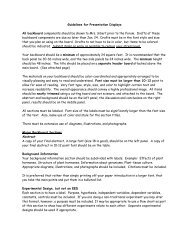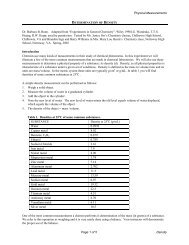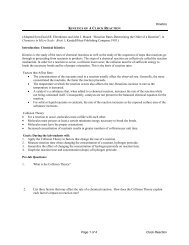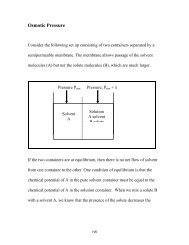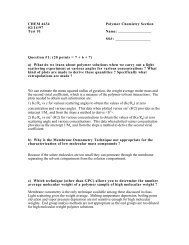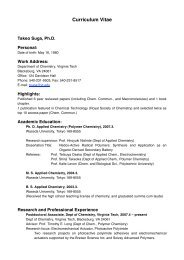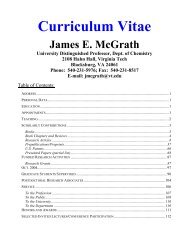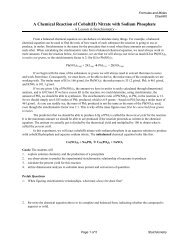The Gelation of Polyvinyl Alcohol with Borax
The Gelation of Polyvinyl Alcohol with Borax
The Gelation of Polyvinyl Alcohol with Borax
You also want an ePaper? Increase the reach of your titles
YUMPU automatically turns print PDFs into web optimized ePapers that Google loves.
<strong>The</strong> <strong>Gelation</strong> <strong>of</strong> <strong>Polyvinyl</strong><strong>Alcohol</strong> <strong>with</strong> <strong>Borax</strong>Jeff MaciborskiTony Salamone5/1/01Instructor – Dr. Marand
<strong>Gelation</strong> Synthesis• Polymerization <strong>of</strong> vinyl acetate• Hydrolysis <strong>of</strong> poly(vinyl acetate)
<strong>Gelation</strong> Synthesis• Boric Acid – Borate Buffer• <strong>Gelation</strong> <strong>of</strong> Poly(vinyl alcohol)
PVA – <strong>Borax</strong> Gel Characteristics• Water Soluble• Gel able to form at very low soluteconcentrations• Network structure responsible for “slime”like properties-Tetrafunctional cross-links-Reformable hydrogen bonds
• <strong>The</strong>rmoreversible versuspermanent• <strong>The</strong>rmoreversible gelstransform from solidliketo liquid-like format a characteristic temp• Permanent gels madefrom solvent saturatedcovalently bondedpolymer networks.• Other cross-linkingmechanisms:Gel Properties
SLIME LAB• Add two or three drops <strong>of</strong> food coloring to boraxsolution (cup A)• Mix thoroughly <strong>with</strong> proper laboratory agitationutensil (a.k.a. pop-sickle stick)• Pour PVA solution (cup B), followed by borax/foodcoloring solution into Wall-Mart brand plastic bags.Be extremely careful in handling bags.• Shake vigorously until mixture thickens• Remove gel from bag; proceed <strong>with</strong> the tomfoolery• Do not eat or place in any parts <strong>of</strong> the body whereretrieval might be difficult



